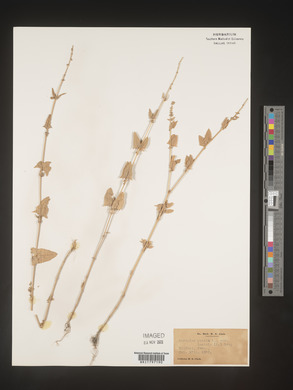Atriplex prostrata
|
Atriplex prostrata Boucher ex DC.
 (redirected from: Atriplex patula subsp. hastata sensu Hall & Clements 1923, non (L.) Hall & Clements) (redirected from: Atriplex patula subsp. hastata sensu Hall & Clements 1923, non (L.) Hall & Clements) |
|
|
Family: Amaranthaceae
Hastate Orache
[Atriplex hastata sensu Aellen, non L., moreAtriplex latifolia Wahlenb., Atriplex oppositifolia , Atriplex patula subsp. hastata sensu Hall & Clements 1923, non (L.) Hall & Clements, Atriplex patula var. hastata auct. non (L.) A. Gray, Atriplex patula var. triangularis (Willd.) Thorne & Welsh, Atriplex prostrata var. triangularis (Willd.) Rauschert, Atriplex triangularis Willd.] |
The name for the species taken up here follows the nomenclatural interpretation of J. McNeill et al. (1983). Herbs, monoecious, erect, decumbent or procumbent, branching, 1-10 dm; stems subangular to angular, green or striped. Leaves opposite or subopposite at least proximally; petiole (0-)1-3(-4) cm; blade triangular-hastate, lobes spreading, 20-100 mm and almost as wide, base truncate or subcordate, margin entire, serrate, dentate, or irregularly toothed, apex acute to obtuse. Flowers in spiciform naked spikes 2-9 cm, sometimes forming terminal panicles; glomerules tight, contiguous or irregularly spaced. Fruiting bracteoles green, becoming brown to black at maturity, triangular-hastate to triangular-ovate, veined or veins obscure, 3-5 mm, thin to thickened, spongy, base truncate to obtuse, margin united at base, lateral angles mostly entire, apex acute, faces smooth or with 2 tubercles. Seeds dimorphic: brown, flattened, disc-shaped, 1-2.5 mm wide, or black, 1-1.5 mm wide; radicle subbasal, obliquely antrorse to spreading. 2n = 18. Plants erect and to 1 m, or prostrate; lvs green, the principal ones 2-10 נ2-9 cm, hastate to triangular or rhomboidal, with sharp basal angles or lobes; infls lfless except at base; fruiting bracteoles foliaceous and somewhat (but usually not strongly) spongy-thickened toward the base, joined near the base, obscurely to ±evidently veined, 3-10 mm, triangular-hastate to triangular ovate, the lateral angles ±rounded, entire or toothed; seeds dimorphic; brown seeds 1.5-3 mm wide; black seeds harder, 1-2 mm wide; radicle inferior; diploid on x=9. On sea beaches and in salt marshes or saline soil inland; widespread in the N. Hemisphere, but in N. Amer. perhaps only intr. (A. patula var. h.; A. triangularis; A. franktonii) Gleason, Henry A. & Cronquist, Arthur J. 1991. Manual of vascular plants of northeastern United States and adjacent Canada. lxxv + 910 pp. ©The New York Botanical Garden. All rights reserved. Used by permission. Annual herb to 1 m tall Stem: upright, branched, green or striped, angled or nearly so. Leaves: mainly opposite, stalked, 2 - 10 cm long, nearly as wide, triangular to arrowhead-shaped with spreading lobes and a flat or nearly heart-shaped base and blunt to pointed tip, sometimes toothed, more or less mealy. Inflorescence: a 2 - 9 cm long spike of flowers or a branched cluster of flowers (panicle). Flowers: either male or female, borne on the same plant (monoecious), greenish, tiny. Male flowers with five sepals and stamens, no petals. Female flowers without petals and sepals, enclosed within a pair of small, leaf-like bracts (bracteoles). Stigmas two. Fruit: enclosed within a pair of small bracts (bracteoles). Bracteoles united at base, green becoming brown to black, 3 - 5 mm long, triangular arrowhead-shaped to triangular egg-shaped with a flat to rounded base and pointed tip, mostly non-toothed, smooth or with two small projections, spongy. Seeds brown, 1 - 2.5 mm wide, disc-shaped, and flattened, or black and 1 - 1.5 mm wide. Similar species: The similar Atriplex patula idiffers by the shapes of its leaves, which are most often non-toothed or very sparsely toothed along the margins. Flowering: August to September Habitat and ecology: Introduced from Eurasia. Found in a wide variety of disturbed habitats, including lawns, gardens, parkways, and waste ground. May also be found along highways because it tolerates a high degree of salinity. Occurence in the Chicago region: non-native Etymology: Atriplex is the ancient Latin name for this plant. Prostrata means prostrate. Author: The Morton Arboretum From Flora of Indiana (1940) by Charles C. Deam Same habitats as species [Atriplex patula]. Reported from: Benton, La Porte, Madison, Marshall, and Wells Counties. ...... Indiana Coefficient of Conservatism: C = null, non-native Wetland Indicator Status: FAC Diagnostic Traits: lowest leaves opposite, deltate-hastate with truncate bases and scurfy scales; flowers all unisexual and female ones borne between conspicuous, deltate bracteoles.
|













































































